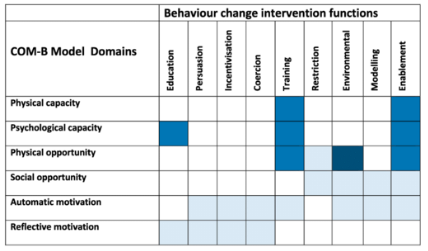Making cycling a habit: Social Change UK and Stirling Council survey


by Alice Coget
Social Change UK and Stirling Council disseminated a survey investigating the cycling habits for students and staff of the University of Stirling’s student and staff in commuting to and from the University. Since Stirling Council developed the cycling route from Stirling town to the University campus, the cycling pathway to the university has tremendously been more secure and visible to future commuters. This change of behaviour necessary for students and staff to become cyclist commuters can be explained through the COM-B model.
What’s the COM-B model for making cycling a habit?
“COM” refers to the Capability, Opportunity and Motivation components necessary to achieve the target behaviour. The COM-B model explains the components needed to make cycling a habit. Capability includes physical stamina and knowledge of cycling. Opportunity involves social acceptance, physical resources like a suitable bike, and the financial ability to maintain it. Motivation encompasses planning and enjoying cycling, making it an automatic habit.
Matrix of the COM-B model including barriers and interventions.

What’s the cost-benefit analysis of cycling?
A cost-benefit study made by the Ministry of Infrastructure in the Netherlands displayed the costs, direct effects, indirect effects and externalities of cycling projects (Davis, 2010). The cost-benefit analysis was calculated by comparing the benefits of replacing one kilometre driven by car or by bus by cycling.

The main cost for an individual remains the initial investment of the bike and the maintenance of it. This purchase nonetheless drives positive direct effects and indirect effects. On the one hand, cycling reduces the driving time for cyclists and reduces traffic. On the other hand, cycling has positive indirect health benefits, increases productivity by decreasing the absence of work, improves subsidies for public transport and decreases the tax revenue from fuel taxes by not relying on the car as a mode of transport. Finally, cycling accounts for positive externalities such as carbon emissions reduction, noise reduction and improved road safety due to reduced vehicle trips.
Overall cycling has a positive economic balance for public services. External benefits include reduced carbon emissions, and noise, improved road safety and reduced health expenditure. In the UK, cycling interventions show a 13:1 benefit-cost ratio (Haubold, 2018).
What are the barriers for cyclists?
Despite these benefits, Stirling has relatively few cyclists. Most people are exposed to barriers that prevent them from cycling regularly to work or to the university. Social Change UK addressed/found that cycling can be identified more as a burden than an advantage.
For instance, the effort and convenience factors divert people from starting cycling, which includes the physical effort required, the time it takes to cycle, planning the journey and the equipment, bad health conditions of certain commuters, the lack of understanding of road rules and not knowing how to ride a bike.
Similarly, cycling can be inaccessible due to the lack of cycling paths, the lack of shower facilities and cycling racks and shelters. It can also be unsafe to ride at night due to the lack of street lighting. Other environmental factors like bad weather or the road terrain being inappropriate to ride correctly due to the steepness and bad road conditions add to the drawbacks. Other factors such as the discomfort of sweating before work or having the need to carry more to work or to university than can fit on a bike make it difficult to adopt cycling.
In a nutshell, the survey by Social Change UK and Stirling Council and the development of cycling pathways reveals that enhanced cycling infrastructure improves safety and visibility for university commuters. This survey aims to understand the cycling barriers through the COM-B framework to increase cycling around Stirling. Despite the perceived challenges like effort and accessibility of riding a bike, the cost-benefit analysis shows significant economic and health advantages of encouraging more cycling behaviour.
Davis, D.A. (2010) ‘Value for Money: An Economic Assessment of Investment in Walking and Cycling’.
Haubold, H. (2018) ‘Cost-benefit analysis for cycling’.
Not cycling, but still putting the new cycle lanes to good use during our Hub’s 10th Birthday celebrations in 2023.



